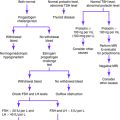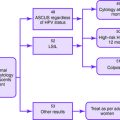Chapter 42 VULVAR PRURITUS
Vulvar pruritus can be caused by a number of different conditions ranging from localized diseases to systemic diseases. The age of the woman is very important in the differential diagnosis. In premenopausal women, contact dermatitis, lichen simplex, and candidal vaginitis are common causes of vulvar pruritus. In postmenopausal women, common causes include atrophic vaginitis, lichen sclerosis, vulvar intraepithelial neoplasia, and vulvar cancer. In patients with diabetes, candidal infections are prevalent.
Medications Linked to Vulvar Pruritus
Amoxicillin–clavulanic acid (can cause cholestasis)
Anabolic steroids (can cause cholestasis)
Erythromycin (can cause cholestasis)
Oral contraceptives (can cause cholestasis)
Penicillin (can cause allergic reaction)
Phenothiazines (can cause cholestasis)
Causes of Vulvar Pruritus
Key Historical Features
✓ Gynecologic symptoms and history
✓ Medical history, especially history of diabetes, thyroid disease, renal disease, liver disease, or malignancy
Key Physical Findings
✓ Examination of the vulva for lesions (note color, texture, location)
✓ Speculum examination to evaluate the vagina and cervix for discharge, lesions, or erythema
Suggested Work-Up
| Scrapings for fungal culture and microscopy | To evaluate for tinea cruris |
| Wet-mount preparation of vaginal secretions | To evaluate for bacterial vaginosis or Trichomonas vaginalis infection |
| Potassium hydroxide (KOH) preparation of vaginal secretions | To evaluate for Candida infection |
| Colposcopy | To evaluate for vulvar atypia |
| Biopsy | If the diagnosis is unclear or if neoplasia is suspected |
Additional Work-Up
| Patch testing | If contact dermatitis is suspected |
| Serum bilirubin measurement | If biliary disease is suspected |
| Liver function tests | If liver disease is suspected |
| Complete blood cell count | If a hematologic disorder is suspected |
| Serum creatinine measurement | If kidney disease is suspected |
| HIV test | If HIV infection is suspected or the patient is at risk |
| Thyroid-stimulating hormone (TSH) measurement | If thyroid disease is suspected |
| Fasting blood glucose measurement | If diabetes is suspected |
| Viral culture | To evaluate for herpes if ulcerative lesions are present |
| Colonoscopy or sigmoidoscopy | If a colonic cause is suspected |
Bohl TG. Overview of vulvar pruritis through the life cycle. Clin Obstet Gynecol. 2005;48:786-807.
Bornstein J, Pascal B, Abramovich H. The common problem of vulvar pruritus. Obstet Gynecol Surv. 1993;48(2):111-118.
Moses S. Pruritus. Am Fam Physician. 2003;68:1135-1142.
Welsh B, Howard A, Cook K. Vulval itch. Austral Fam Physician. 2004;33:505-510.




